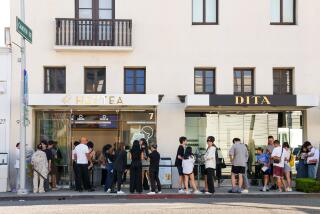Coffee Break Suits Hectic Folks to a Tea
- Share via
Tearoom owner Cynthia Sperry knows a trend when she sees one. Americans’ growing interest in the ceremony of afternoon tea, coupled with her fascination with the beverage, prompted her to open the Best of Times Tea Cottage two years ago. Today, she’ll open the History of Tea Museum in an adjoining room.
The museum, which is totally devoted to the cup’s 5,000-year history, will answer questions Sperry and her servers are often asked by tearoom guests.
Admission to the museum, which is privately funded, is free. Funds from tea items sold help pay the rent.
Recently, such tearooms as the Best of Times have become more popular because the “yearning for something more quiet is a reflection of the times,” Sperry said.
“As the world speeds up, people like to slow down,” she said recently while sipping a black tea known as Yorkshire Gold among a collection of silly hats for customers, a singing parakeet and frilly things in her tearoom.
The basic coffeehouse experience might be a double latte or espresso, usually to go. The idea is to get that coffee buzz and move on, back to the grind. Enter a tearoom and things flow gently, like honey from a silver spoon.
There are 24 teas on the menu at the Best of Times, and 50 in stock. Iced tea is also served.
Sperry is trying to recreate a lovely, leisurely teatime 20 years ago at London’s Ritz Hotel. Then 18, she and a friend ditched a scheduled tour stop of the crown jewels. Instead they headed for afternoon tea.
The experience, which was somehow naughty and nice, whet her appetite for more. “It’s everything dainty and proper and tasty,” she said. “It’s a more elegant version of happy hour.”
After the Ritz, she had a secret desire to bring the experience to others. She has visited about 80 tearooms, mostly in Southern California.
Last summer, in a Central California town, she and her husband visited an especially small museum. After touring the museum, her spouse remarked that they could easily start one. Sperry began feverishly researching tea.
The museum focuses on themes of history, production and tea literature. Exhibits are grouped in areas titled: “China--Tea’s Birthplace,” “The Silk Road,” “The Victorian Influence,” “Marco Polo,” “The Literature of Tea,” “Tea vs. Coffee,” “Tea Rooms Today,” “The Japanese Tea Ceremony,” “The Boston Tea Party,” “Internationaliteas” and others. An audiotape tour with headsets is available for a small fee.
A long list of terminology near the museum entrance reveals that tea fanciers have developed a language as complex as that of wine aficionados. For example, an “autumnal” tea is produced late in the growing season. The term for tea that has been over-fired is “bakey.” And “brassy” describes a tea that has an unpleasant acidic bite from improperly withered tea leaves.
In one area, a tea brick known as “black gold” sits on a traveling trunk; tea was used as currency in China.
The museum is stocked with items such as Chinese porcelain, an antique tea cart (part of the Victorian exhibit), a miniature Japanese tea garden and tea sets from all over the world. Silver strainers, cozies and other paraphernalia abound.
A description found in the “Literature of Tea” section perhaps best sums up what afternoon tea is all about: “Whimsey, ceremony and detail are embraced as guests immerse themselves in an era and way of life goneby.”
Besides giving her tearoom guests a respite, Sperry feels the unique museum can help make its seaside city more of a destination. “First of all, it’s to give to Seal Beach. It’s [the city] not listed in a lot of guidebooks.”
*
The History of Tea Museum and the Best of Times are at 814 Electric Ave. The museum is open Monday-Saturday, 11 a.m. to 6 p.m.; Sunday, noon-4 p.m. The tearoom is open Tuesday-Saturday, 11 a.m. to 4 p.m.; Sunday, noon-3 p.m.
More to Read
Sign up for The Wild
We’ll help you find the best places to hike, bike and run, as well as the perfect silent spots for meditation and yoga.
You may occasionally receive promotional content from the Los Angeles Times.






